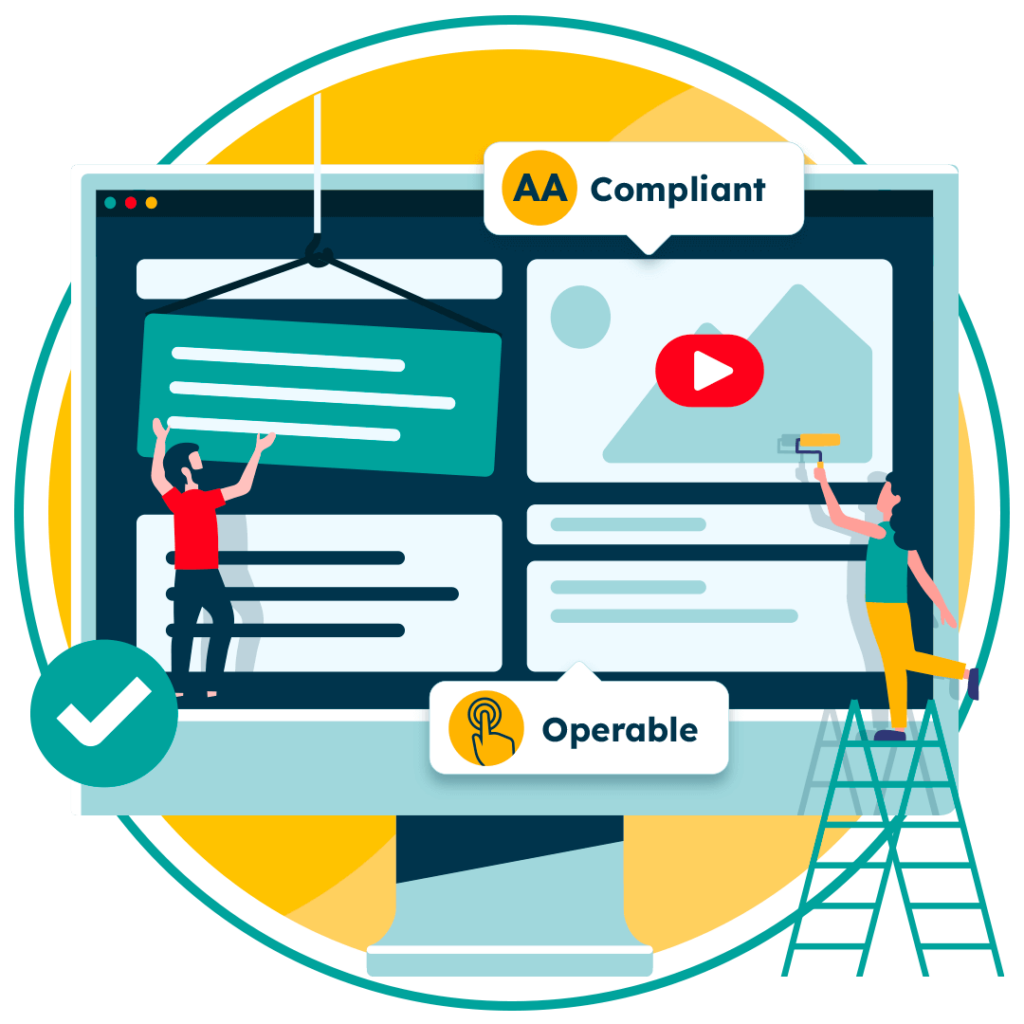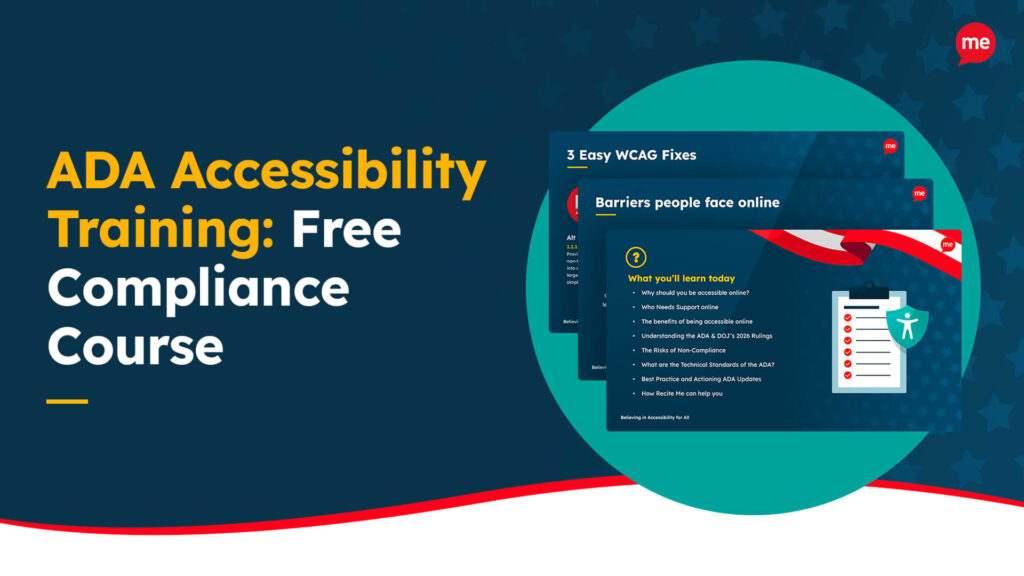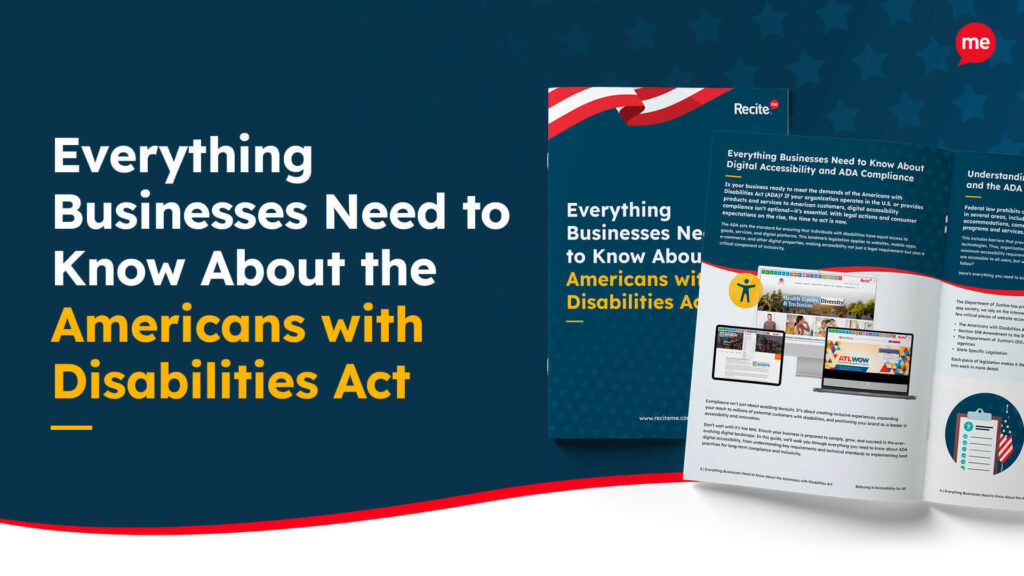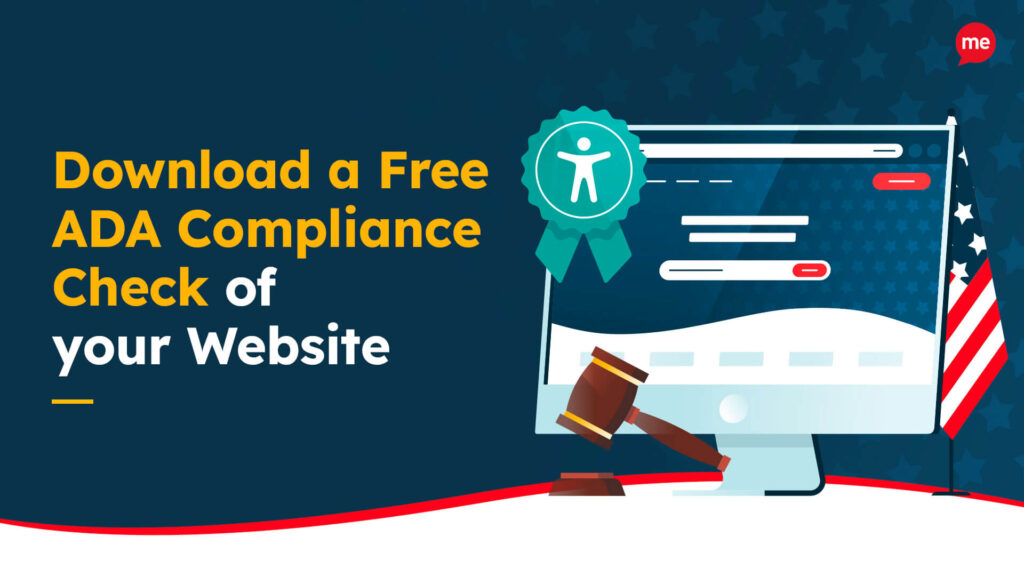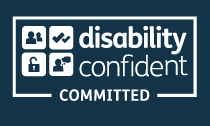Get A Free ADA Compliance Audit Of Your Website
Download NowThe Americans with Disabilities Act (ADA) stands as a legislative beacon of inclusivity, championing equal access for all. However, as the virtual realm continues to expand, so too does the task of ensuring sustained accessibility.
Every click, scroll, and interaction online plays a small role in shaping the landscape of commerce and communication. But what happens when online access barriers prevent individuals from fully participating in the digital world?
The legal implications of non-compliance can be severe, making it crucial for organizations to understand their roles and responsibilities regarding ADA web accessibility compliance. In this comprehensive guide, we’ll help you learn how to avoid ADA lawsuits. We’ll cover:
- ADA definition and compliance basics.
- The Web Content Accessibility Guidelines (WCAG) and their role in ADA compliance.
- Which WCAG version and level websites should aim to meet.
- The most common ADA web accessibility violations.
- Web accessibility lawsuit statistics and trends.
- ADA web accessibility compliance lawsuit examples.
- How to avoid ADA web compliance lawsuits.
- What to do if you receive an ADA demand letter or lawsuit.
- The costs and consequences of an ADA lawsuit.
- ADA web compliance lawsuit FAQs.
What is the Americans with Disabilities Act?
The Americans with Disabilities Act (ADA) is a landmark piece of civil rights legislation established in 1990 and signed into law by President George H.W. Bush. The ADA’s overarching goal is to ensure equal opportunities by prohibiting discrimination against individuals with disabilities.
When the ADA was first enacted, the focus was on physical accessibility, ensuring individuals with disabilities were protected against discrimination when accessing employment, public accommodations, transportation, etc. However, as the modern world evolved to encompass increasingly digital spaces, the ADA’s scope was expanded to include online platforms as places of public accommodation, making the ADA equally applicable to public-facing websites.

What is ADA Website Compliance?
ADA website compliance refers to the process of ensuring that websites are accessible to individuals with disabilities. This means making sure web content is functional and usable by people with various disabilities, including visual, auditory, motor, and cognitive impairments.
The ADA comprises five Titles in total, three of which three relate specifically to digital accessibility:
ADA Title I Compliance
ADA Title I covers employment discrimination. To comply, organizations must:
- Having an accessible website.
- Provide inclusive candidate journeys.
- Make information regarding recruitment, hiring, promotions, training, job assignments, and termination accessible to everyone.
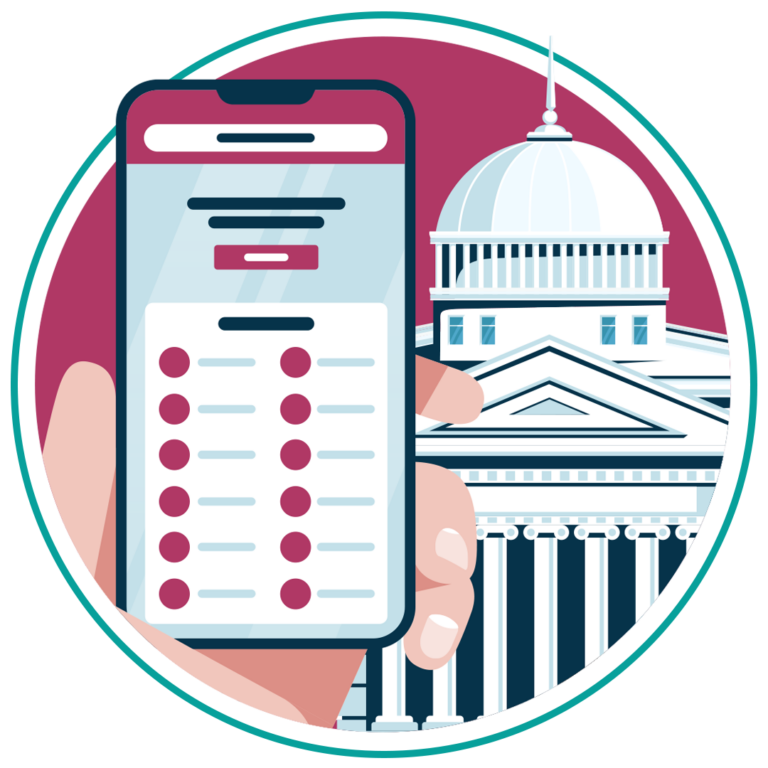
ADA Title II Compliance
ADA Title II covers the accessibility of public services, programs, and activities. To comply, state and local government offices must make digital information equally available to disabled and non-disabled citizens.
Given the recent DOJ accessibility ruling, the time to act is now:
- April 24, 2026: Public service bodies serving over 50,000 people must be ADA compliant by this date.
- April 26, 2027: Public service bodies serving less than 50,000 people must be ADA compliant by this date.
ADA Title III Compliance
ADA Title III covers access to the products and services offered by public-facing businesses. To comply, companies must ensure individuals with disabilities have full and equal online access to their goods, services, facilities, privileges, advantages, etc.
Want to make sure your website is compliant with the Americans with Disabilities Act? Then unlock the ADA compliance checklist now. Discover actionable steps to ensure ADA compliance, helping you avoid lawsuits and any other negative consequences of non-compliance.
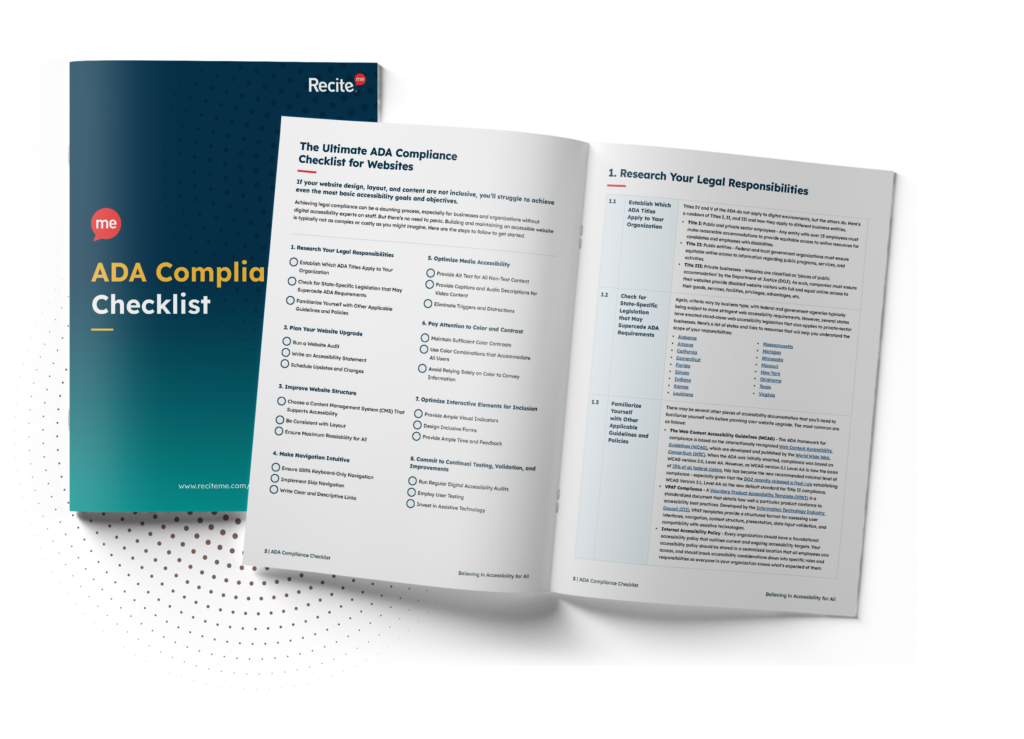
The Role of WCAG in ADA Compliance
The Web Content Accessibility Guidelines (WCAG) are the globally accepted gold standard of website accessibility, and the ADA has been developed using WCAG principles as a framework to ensure maximum impact. In theory, this makes the process of developing an ADA-compliant website straightforward, as building online platforms that comply with WCAG standards ensures compliance with ADA criteria by default.

WCAG in a Nutshell
WCAG criteria are published by the Worldwide Web Consortium (W3C). There have been several iterations since the W3C was founded in 1994, each new version becoming more comprehensive in line with technological development and the proliferation of online platforms.
Through the establishment of specific success criteria and compliance levels, the Web Content Accessibility Guidelines show website owners and developers how to design and maintain accessible websites for all.
The ‘POUR’ Principles of WCAG
- P = Perceivable: Information must be presented in ways that users can perceive, encompassing various sensory modalities.
- O = Operable: Interface components and navigation must be operable by all users and assistive technologies.
- U = Understandable: Content must be organized logically, using clear language and navigation structures to facilitate comprehension.
- R = Robust: Reliable content interpretation should be possible using a wide range of user agents, including screen readers.

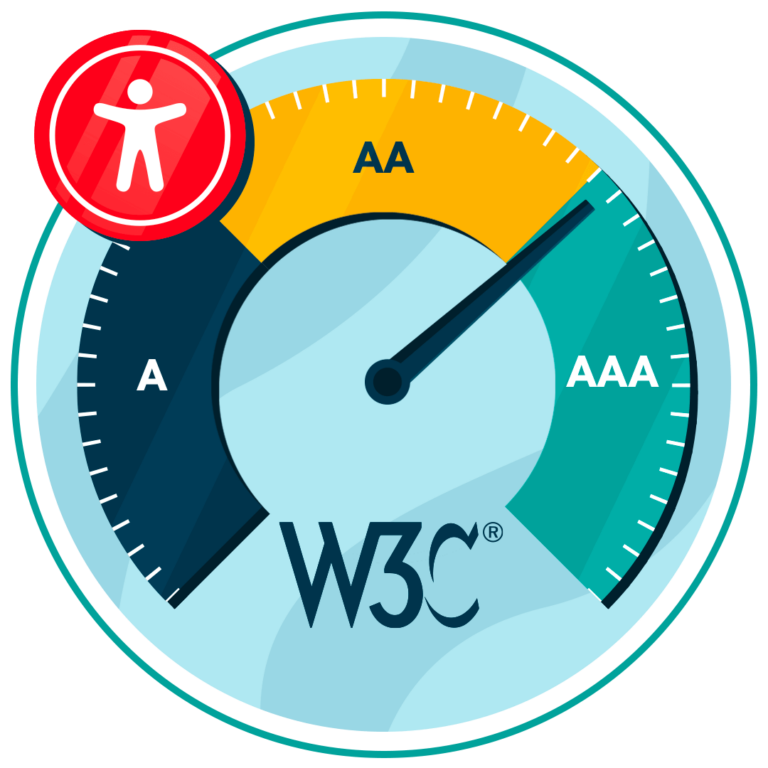
WCAG Compliance Levels
- Level A: Basic – 30 fundamental accessibility criteria that must be met to make a website technically accessible.
- Level AA: Industry Standard – An additional 30 criteria required to meet an industry-accepted standard of accessibility.
- Level AAA: Advanced – The highest level of accessibility with a total of 78 criteria, which, while desirable, may not be practical or necessary for all websites.
Which WCAG Version and Level Should Websites Aim to Meet?
Published in October 2023, the most up-to-date version of WCAG is 2.2, and WCAG 3.0 is on the way very soon. However, current ADA web accessibility legislation only requires WCAG 2.0 Level AA compliance. That said, there are several reasons why enhanced compliance is recommended:
- 75% of all federal claims reference the most up-to-date version, WCAG 2.1AA.
- In 2022, the DOJ announced proposed changes to regulations that would establish WCAG 2.1 Level A/AA as the basis for Title II compliance.
- Aside from anything else, making online content accessible to as many people as possible is simply the right thing to do.
The Most Common ADA Web Accessibility Violations
While the list of potential pitfalls is lengthy, the highest volume of ADA violations stem from failure to make products and services equally accessible to individuals with disabilities, as per Title III. The list of most commonly cited ADA Title III violations includes:
- Lack of text alternatives (alt tags) for non-text content.
- Lack of/insufficient keyboard navigation.
- Unlabeled dropdown menus.
- Insufficient color contrast.
- Incompatibility with screen reader software.
- Inaccessible forms.
- Empty button elements.
- Missing or improper use of ARIA roles and landmarks.
- Video and audio without captions or transcripts.

How Common are ADA Website Lawsuits?
The short answer: increasingly common!
We’ve broken down some key data into national and state trends below. However, it’s essential to note that these figures only represent the number of ADA web accessibility lawsuits that proceed to trial. Many more are dismissed, voluntarily withdrawn, or settled in closed-record out-of-court agreements.
Nationwide ADA Web Accessibility Lawsuit Trends
The number of ADA-based web accessibility lawsuits continues to rise year-on-year. Here’s a quick breakdown of the number of cases recorded over the last few years:
- 2017 – 814
- 2018 – 2314
- 2019 – 2890
- 2020 – 3503
- 2021 – 4011
- 2022 – 4061

The final 2023 web accessibility lawsuit report has yet to be published. However, preliminary research suggests the volume of web-based ADA lawsuits is still rising exponentially.
State ADA Web Accessibility Lawsuit Trends
Location can significantly affect the likelihood of being taken to court for ADA-related accessibility failures. The states with the highest number of digital accessibility lawsuits are:
- New York – Of all federal and state cases in 2023, almost 75% were filed in New York.
- Florida – With a growing reputation as a ‘hotbed’ for website accessibility lawsuits, Florida is estimated to account for up to 25% of the nation’s annual total.
- California – Between January and July 2023 alone, 477 web accessibility cases were filed through California State courts.
However, it’s also essential to note that businesses don’t need to have a physical, in-state presence to be taken to court for ADA violations. Any company with a digital presence (e.g., a website) can have legal action initiated against it. Hence, there have been several instances of lawsuits involving plaintiffs and defendants from completely different locations.
Get a free automated ADA compliance audit of your website. This audit will highlight compliance violations and provide the recommendations needed to meet ADA compliance standards.
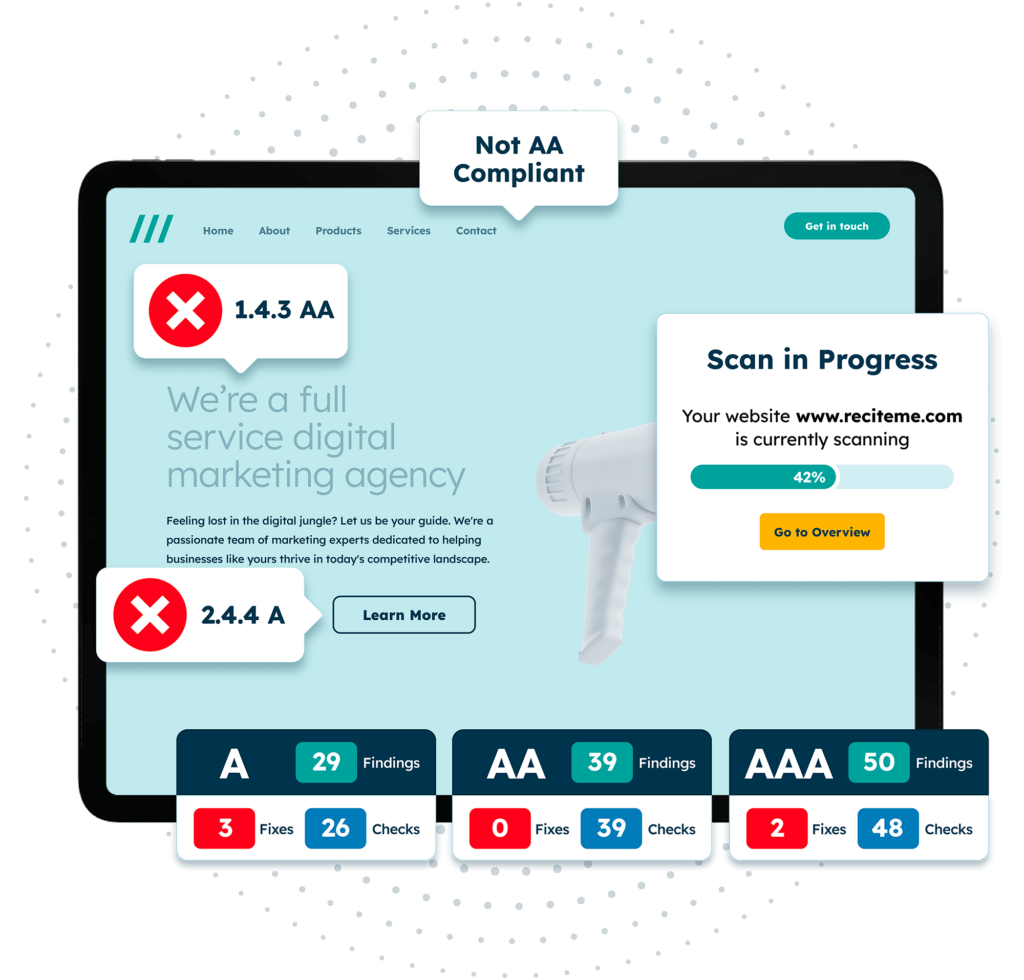
High-Profile ADA Compliance Lawsuits
With the notable exceptions of religious organizations and private country and social clubs, no business is exempt from meeting ADA digital accessibility requirements.
Small businesses are often viewed as easy targets because they are more likely to settle out of court. However, that’s not to say that plaintiffs have not targeted – and been victorious – in taking legal action against large corporations. Here are a few notable examples of landmark cases that have shaped the landscape of ADA-based web accessibility rulings.
National Federation of the Blind (NFB) v. Target Corporation
Legislation used: ADA Title III
Case description: The NFB filed a class-action lawsuit against Target, citing ADA Title III violations that made the retailer’s website inaccessible to individuals with visual impairments.
Outcome: Target settled the lawsuit for $6 million and made additional guarantees to improve website accessibility going forward.

Guillermo Robles v. Domino’s Pizza
Legislation used: ADA Title III
Case description: Guillermo Robles’ filing against Domino’s Pizza was based on the company’s website and mobile app being inaccessible to individuals with visual impairments.
Outcome: The Ninth Circuit Court of Appeals ruled in Roble’s favor. The financial details of the settlement remain unknown. However, the pizza giant undoubtedly spent hundreds of thousands of dollars fighting the case.
Juan Carlos Gil v. Winn-Dixie Stores
Legislation used: ADA Title III
Case description: Juan Carlos Gil alleged the Winn-Dixie website was not accessible based on his individual needs, which included being legally blind and having cerebral palsy.
Outcome: Winn-Dixie was ordered to make its website compliant with WCAG 2.0 AA standards, set aside $250,000, commit to providing annual employee training, and adopt a web accessibility policy.
National Association of the Deaf (NAD) v. Netflix
Legislation used: ADA Title III
Case description: NAD claimed the streaming service failed to provide adequate closed captioning for its content.
Outcome: NAD was victorious, although the precise monetary damages related to the settlement are unknown. However, the deal included a commitment by Netflix to ensure 100% closed captions on all on-demand programming within two years.
How to Avoid ADA Web Compliance Lawsuits
Learning how to avoid ADA web compliance lawsuits may feel daunting. However, taking proactive steps to ensure websites are accessible to all users is typically not as complex – or as costly – as most organizations imagine. Here are the critical steps to follow:
- Understand your obligations – Familiarize yourself with the requirements of Titles I, II, and II, and establish which measures are relevant to your organization.
- Research state and local laws – Many states have enacted stand-alone web accessibility legislation that exceeds ADA requirements. Examples include California, Illinois, Minnesota, Indiana, Michigan, New York, Massachusetts, Virginia, Alabama, and Connecticut.
- Conduct regular accessibility audits – Run scans and audits comprising both automated and manual testing techniques. Tools like the Recite Me Accessibility Checker help by identifying non-compliance issues and generating a prioritized fix queue based on WCAG criteria.
- Update Your Website – If you haven’t already, update your website to ensure a fully accessible design. For more information, tips, and actionable processes to work through, check out the following resources:
- Publish an accessibility statement – Displaying an accessibility statement on your website communicates your dedication to current and future digital accessibility goals. Learn more about how to write an accessibility statement today. Alternatively, you can use the free Recite Me Accessibility Statement Generator.
- Commit to continuous improvement – The digital landscape is constantly evolving, so continuous accessibility monitoring is required to ensure sustained compliance in line with the most up-to-date legislation and guidelines.

What Happens When You Receive an ADA Demand Letter or Lawsuit
Being on the receiving end of an ADA lawsuit is a daunting experience for any business. However, understanding the typical process and steps involved makes it much easier to navigate the situation effectively. Here’s an overview of the process and steps you should take.
1. Receiving the Demand Letter
A demand letter is a formal notice indicating that your website is allegedly non-compliant with ADA standards. The letter typically outlines specific accessibility issues identified and may demand corrective action, compensation, or both.
If you receive a demand letter, don’t panic! In many cases, ‘tester’ plaintiffs send demand letters to multiple organizations simultaneously containing the same information. However, you should still review the claims carefully and run an accessibility audit immediately to determine whether they’re relevant to your website. It is advisable to engage a lawyer with expertise in ADA compliance and internet accessibility legislation to guide you.
2. Responding to the Complaint
You must respond to the complaint within the specified timeframe, usually 20 to 30 days from the date of receipt. Failure to respond can result in a default judgment against your business. In your response, you should outline your position clearly and, if applicable, propose a plan to address the accessibility issues.

3. Building a Defense
Your lawyer will help you build a defense by gathering evidence to demonstrate your commitment to accessibility. This may include:
- The results of your accessibility audits.
- Documentation of your efforts to fix accessibility issues.
- A published accessibility statement.
4. Negotiations and Settlement or Trial
Many ADA lawsuits are settled out of court. Your lawyer may negotiate with the plaintiff to reach a settlement that may involve:
- Making the necessary changes to your website.
- Paying a settlement fee.
If a settlement cannot be reached, the case may proceed to trial. During the trial, both parties will present their arguments and a judge will determine the outcome based on the evidence provided.
5. Post-Trial Actions
Regardless of the outcome, it’s crucial to address any accessibility issues identified and implement measures to prevent further potential lawsuits. So, in addition to implementing the necessary changes to fix the accessibility issues cited in the lawsuit, you’ll need to regularly monitor your website to ensure ongoing compliance with ADA standards.
What are the Costs of an ADA Web Accessibility Lawsuit?
ADA website lawsuit settlements reached between plaintiffs and defendants outside of court typically range from $5,000 to $15,000 – and even successful defense cases carry a cost. However, the financial penalties can increase significantly once a lawsuit proceeds to trial.
Here’s a comprehensive list of financial considerations:
- Statutory damages – ADA fines start at $55,000 for a first violation and rise to $110,000 for subsequent violations.
- Compensatory damages – Businesses may be required to pay compensatory damages to the plaintiff to cover emotional distress and expenses related to finding alternative services.
- Attorney fees – In addition to your own fees, the court can order businesses to cover plaintiff attorney fees and other legal costs.
- Remediation costs – The cost of ADA website accessibility remediation and the action needed to make the website accessible.
- Resource costs – Addressing an ADA lawsuit requires considerable time and resources, which may necessitate diverting funds from other critical operations.

Additional Consequences of an ADA Web Accessibility Lawsuit
Beyond the immediate financial cost of a web accessibility settlement or lawsuit, several indirect factors can lead to even more revenue losses:
- Negative PR – News of non-compliance and subsequent lawsuits can spread quickly, leading to negative public perception and potential loss of customer trust.
- Reduced brand loyalty – Customers, especially those who value inclusivity and accessibility, may choose to take their business elsewhere.
- Reduced employee morale – The stress and uncertainty of a lawsuit can affect employee morale, leading to reduced productivity and a higher turnover rate.
- Reduced stakeholder morale – Involvement in non-compliance lawsuits may result in reduced stakeholder confidence and make it challenging to form new partnerships and attract investors.
Discover everything businesses need to know about the Americans with Disabilities Act. Learn how you can protect your business from costly lawsuits, reach millions of potential customers with disabilities, and build a brand known for inclusivity and innovation.
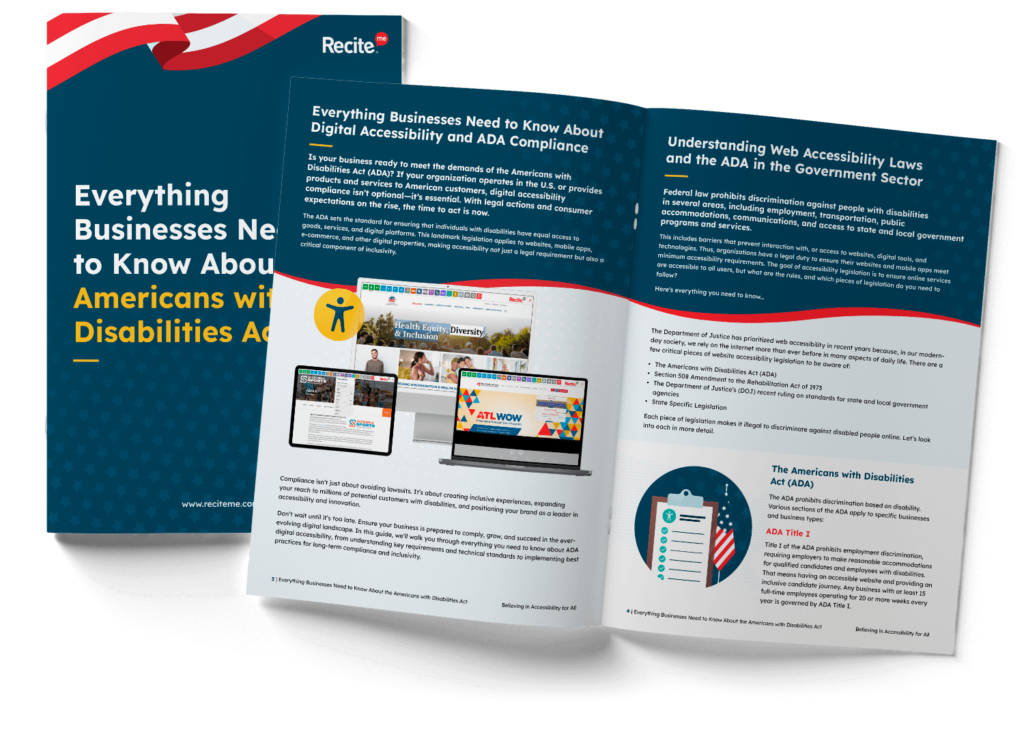
Act today before it’s too late!
Whether you work for a public body or a private organization, ADA compliance has never been more important. By ensuring your website and digital environments are accessible to people with disabilities you can mitigate against the likelihood of an ADA lawsuit.
Get started today by getting a free ADA compliance audit of your website. Or reach out to one of our accessibility experts for additional support and guidance.
ADA Web Compliance Lawsuit FAQs
Here’s a quick Q&A section to answer our most frequently asked questions, summarize what we’ve learned about ADA web compliance lawsuits, and reinforce the key points.
Does ADA website accessibility legislation apply to private entities?
Yes. While Title II relates specifically to public sector offices and agencies, Titles I and III apply to private and public-facing organizations, regardless of size or industry.
What do the Web Content Accessibility Guidelines have to do with ADA compliance?
The ADA uses WCAG criteria as a framework. So, compliance with WCAG standards equates to ADA compliance by default.
Is ADA compliance mandatory?
While the ADA does not explicitly mention websites, courts have increasingly interpreted the Act to include web accessibility, as the DOJ considers digital platforms to be places of public accommodation. So, ensuring your online content is accessible is essential to avoid potential lawsuits.
Can I be sued for non-compliance from another state?
Yes. The ADA is a federal law, meaning that any individual, regardless of their location, can file a lawsuit if they encounter accessibility barriers on your website.
What are the average settlement amounts for ADA website lawsuits?
ADA website lawsuit settlements typically range from $5,000 to $20,000. However, small businesses may settle for less, and large brands may have to pay significantly higher sums.
Need more help becoming ADA compliant?
The following resources are packed full of actionable tips and expert advice for making your digital content compliant with the Americans with Disabilities Act:
Free ADA Accessibility Training
Take the first step to ADA compliance by completing our training course.
Free ADA Accessibility Guide
Ensure your organization is meeting the requirements for ADA compliance.
